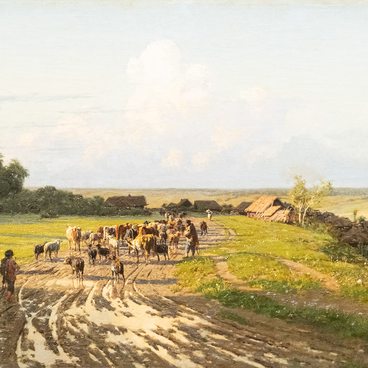Vladimir Ariyevich Grinberg studied painting and drawing under the artist Andrey Matveyevich Volochinkov in Rostov-on-Don. Grinberg studied at the Polytechnic Institute and the New Art School of Princess Maria Dmitriyevna Gagarina; he also attended the workshops of the painter and engraver Osip Emmanuilovich Braz, the artist Mstislav Valerianovich Dobuzhinsky, the graphic artist Dmitry Nikolayevich Kardovsky, the artist Yevgeny Yevgenyevich Lanceray and the painter Alexander Yevgenyevich Yakovlev.
From 1915, he participated in exhibitions organized by the Mir Iskusstva art association, the Sixteen Group, and the Association of Artists of Revolutionary Russia. From 1919 to 1922, he taught at an art school, then at the Workers’ University in Rostov-on-Don; after that, he moved to Petrograd.
Grinberg participated in exhibitions of Soviet art held in the USA in 1924–1925; he also went to Japan, France, and Italy.
He died in 1942 in besieged Leningrad.
Besides the Pskov Museum, Vladimir Grinberg’s works are kept in the State Museum of the History of Saint Petersburg, the Rostov Regional Museum of Fine Arts, the Galeyev Gallery in Moscow, and the State Russian Museum. His artistic legacy consists of paintings, graphic works, book illustrations and sculptures.
Five paintings by Vladimir Grinberg were acquired for the Pskov Museum collection after a large solo exhibition of the artist’s works held in the halls of the Leningrad Organization of the Artists’ Union of the USSR. The paintings belong to different genres. They are based on the motives of everyday life in Leningrad.
In the painting “Winter Evening. Twilight upon the Neva River”, the artist depicted a place not far from his house. He painted the historical center of Leningrad from the windows of his apartment located on Palace Embankment, 28. Grinberg depicted this view at different times of the day and year.
The canvas shows the wide misty expanse over the
Neva River, the blurred outlines of the opposite shore, the silhouette of the
Admiralty tower and its spire. The image uses a gray-blue palette. The artist
placed just a few passers-by along the parapet of the embankment. The
foreground shows a corner of a gray building and a man’s figure in dark clothes on the
right. On the left, there is a silhouette of another figure in dark clothes
with the back turned.


